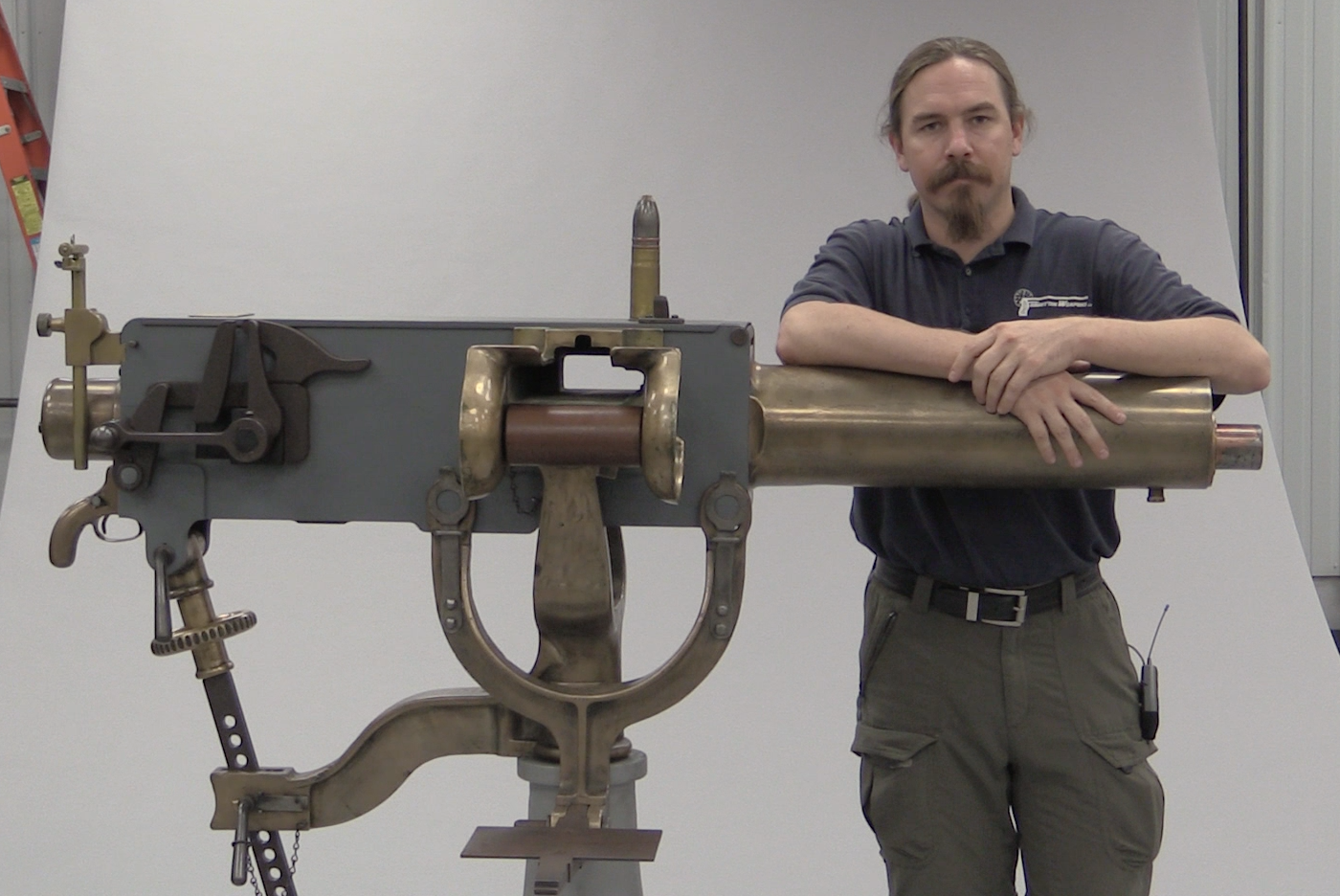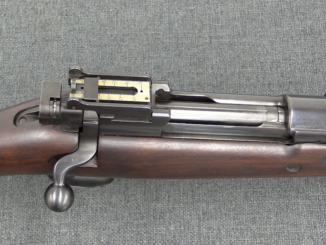In an effort to take advantage of Jim Bowie’s popularity, George Elgin patented a huge knife attached to a single shot percussion pistol in 1837. The idea was simply to offer a dual-purpose weapon, and it proves that human nature never does change much. I suspect that in actual use the weapon would have been pretty awkward – bulky to carry, heavy for a pistol, and clumsy for a knife. However, that didn’t stop two different manufacturers from making them on license, and several hundred willing buyers from shelling out money. In fact, the US Navy even purchased 150 of them for use in the South Seas, making the Elgin the first percussion handgun formally used by the US military. This particular one for sale at RIA is a commercial model made by Morrill, Mosman, and Blair.
Elgin’s 1837 patent was one of the briefest I have yet seen, too. Have a look:




How does the weight of the blade affect the handling of the pistol? Does it make it excessively muzzle heavy?
Overall, it seems to be designed more for looks than for practicality. It’s not alone in the firearms field when it comes to that.
I am surprised that this device can be patent. So far I know:
-the joining of known devices can’t be patented
-if you can find existing device crafted before the issuing of patent, the patent will not be granted – doesn’t knife/pistol like this exist earlier?
The pistol/knife combination has very long tradition and still are in use – for example Soviet 6P25U knife: http://en.wikipedia.org/wiki/NRS-2
he patented the methods to attach a bowie knife to a hand gun not the hand gun itself.
“…bulky to carry, heavy for a pistol, and clumsy for a knife.”
And dangerous as hell to ram a ball down the bore past that knife point.
No more so than ramming a ball down a musket with a fixed bayonet, and military personnel were trained to do that by reflex and muscle memory back then.
cheers
eon
If you want anything crazier than this less-than-viable miniature cutlass, try a cavalry saber with a pin-fire revolver serving as the grip in such a manner that simply pointing the saber towards one’s intended victim lines the sight picture…
“En-garde, monsieur le capitaine!” BANG!
“No.”
Well, if there are two thugs jumping you and you only have one shot, it’s probably better than nothing. Or, you could carry a brace of regular pistols and a large Bowie knife. I have to agree that it would be tricky to load with that big old blade sticking out past the muzzle, but it is kind of cool looking, though. The blade does look more useful than the Webley-Pritchard pig sticker, especially for slashing. I’ve got a cheap Bowie in my parts box, and if I get bored enough or drunk enough, I may just fashion a rail adapter on the grip and make a Glock/SIG/HK version for fun.
I’m having flashbacks to Halo 3, and the Brute Spiker…
I’ve been seeing pictures of these in “weird firearms” books since I was a kid, and it’s fascinating to finally really get a 360° look at one. The bevel on the upper edge always made it look in side views like the blade was absurdly thick — more like a wedge than a knife blade. This looks a little handier, at least.
Some manufacturers apparently extended the trigger guard down to the end of the grip as a hand guard, making it more truly cutlass-like.
I think I’d prefer the Webley with the Pritchard bayonet.
Looks dangerous to load especially in a hurry. But it should be a way to accomplish since muzzle loading rifles of that era with attached bayonets had same hardness.
If you subtract the Bowie-type blade, the Elgin is a pretty basic “boot pistol” of the period, and was about s simple and mule-stupid as a handgun can get. Simplicity is something that is desirable in a CQB weapon, at any tech level.
According to Winant (Firearms Curiosa</em, pp.26-32 NRA reprint ed.), the Allen-made Elgins cost the U.S. War Department $17.50 each, including the special holster/sheath ("caped" at the bottom with "German silver"), cleaning and loading equipment, and a storage box for each pistol. Keep in mind that this was roughly the way Allen delivered their commercial pistols such as boot pistols and pepperboxes at the time. The "scabbard" (holster) housed a separate ramrod, each pistol came with three spare "cones" (percussion-cap nipples), and one "wrench" (dismounting tool) was included with each 10 pistols.
The Allen pistols had another difference with the MM&G-made ones. The blade was attached to the barrel by a long slotted bar forged integrally with the barrel; the back of the blade slotted into this, and two transverse screws secured it. The MM&G pistol appears to have the blade attached to the barrel and receiver both, either forged with the barrel or (more likely) sweated or welded in place.
Also note that some of the Allens had a "knuckle-bow" forged integrally with the trigger-guard and grip; others had no such device.
Of the 150 pistols delivered to the U.S. Navy, most if not all went to sea with the South Sea Exploring Expedition. Commanded by Lt. Charles Wilkes, it consisted of the sloops-of-war Vincennes and Peacock, the brig Porpoise, the pilot schooners Flying Fish and Sea Gull, and the stores ship Relief.
The expedition departed Hampton Roads 19 Aug 1838, rounded Cape Horn three weeks later, and spent the next four years charting the Pacific. In the process, they were the first to sight Antarctica (on 19 Jan 1840; Wilkes Land is named for the mission CO),discovered Wake Island (19 Dec 1841), and conducted several actual combat actions against the natives on various islands, mainly in response to said natives' custom of killing mariners who landed on their islands for whatever reason. In these actions the Elgin pistols, which were issued to officers and bosuns, apparently proved effective in close combat, where there generally wasn't time to reload.
In one case a surveying party of three men was attacked by a small "war party" of natives on one of the Marshall Islands, Two men were felled by spears. The officer shot one of the attackers with his Elgin, split another one's head open with a blade stroke, and then made the mistake of trying to run for the john boat, thereby receiving a spear between the shoulderblades. (Moral; never turn your back on an armed assailant. Charge or stand your ground. And having a backup weapon never hurts.)
The mission returned to New York Harbor on 10 June 1842, having crossed the Pacific three times back and forth, and surveyed over 200 islands plus the coastlines of Antarctica and the Pacific Northwest as far north as what is now Anchorage, Alaska.
The Elgin pistols made by Allen remained in the U.S. Navy inventory until the 1860s. It's likely that some were still in use during the Civil War.
(Goodspeed, M. H., U.S. Navy; A Complete History, Naval Historical Foundation, 2003, pp.118-123.)
The commercial MM&G Elgins were made in larger numbers than the naval Allens, apparently. At least some made their way to the California gold fields during the 1849-51 Gold Rush, but practically every small-arm made in the U.S. or Europe from 1800 on probably saw at least some service there, because the prospectors, authorities, and everyone else would literally take anything that would shoot, and pay well for it.(A pair of .41 caliber Slotter & Co. Derringers that sold for $20 in New York went for $200 in San Francisco at the time.)
The Elgin may look a bit odd today, but in its own “combat environment” it was good enough to get the job done. And that’s really all you can ask of any tool.
cheers
eon
There’s a company called laserLyyte that makes a pistol bayonet… these are usually seen affixed to spur-trigger micro-revolvers to make a weapon that serves no useful purpose whatever.
Well, for someone who wants an ultra-mini survival kit, like the old .22 pocket-knife pistols, it does eliminate one extra widget from the package.
😉
cheers
eon